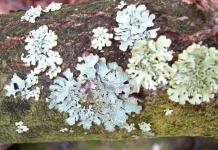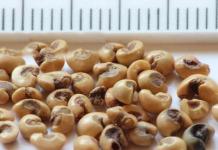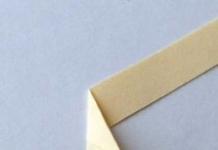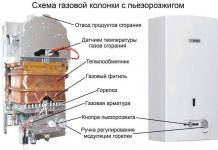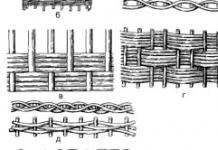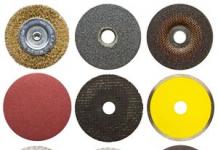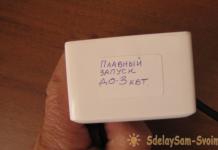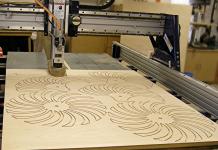We continue to create luxurious flowers and decorations with our own hands from new materials.
Using this master class, make a peony from foamiran, which is suitable for decorating a brooch, hairpin or hair hoop. Plastic suede is very practical - it is not afraid of water and high temperatures, holds its shape well and is absolutely safe for children and adults. The flowers turn out realistic and are difficult to distinguish from real ones. At the same time, needlework does not require much effort, is suitable for beginners and brings great pleasure.
Preparation of materials and tools
To make a peony from foamiran with your own hands, prepare:
- hot pink foamiran (don’t know what it is? about the material and how to work with it);
- green foamiran;
- oil pastels purple, red, green;
- petal patterns;
- wire;
- scissors, ruler;
- glue gun;
- stick or toothpick;
- iron.
In order to make a flower that is close to the real one, it would be nice to have a live sample or a visual picture in front of you. For clarity, we took a photo of a terry peony of the Nakhodka variety. 
The presence of peonies in flower arrangements has become a highlight of this year. We recommend making felt from our other master class. Also be sure to check out how to make a plastic suede hair clip.
How to make a peony from foamiran
Templates for peony petals need to be made from cardboard, first cutting out squares and rectangles:
- And the size is 4x4.5 cm (width/height);
- B size 5.3x5.5 cm;
- Size 5.5x5.5 cm;
- D size 5.5x6.5 cm.
Cut out approximately the same templates as you see in the photo.

Using the peony pattern, trace the necessary details on foamiran, a stick or a toothpick.

Cut out 12 pieces of parts A, 8 pieces - B, 6 pieces - C, 18 pieces - D.

Color parts A as shown in the photo using red and purple pastels.

Unlike A, B, C, color parts D only in purple (outline and rays).

The formation of petals occurs under the influence of high temperature. To do this, use an iron.
Parts A, heat, twist into an accordion, knead with your fingers, scrolling in a spiral.
Form blanks B and C in stages. First, heat the tip and twist. Heat the middle part of the foamiran petal, give it a convexity, stretching it across the width.

Form blanks G in the same way as the previous two, but at the end heat the side sections and twist them back, as shown in the photo of the master class.

Take a wire if you want to make a peony on a stem, or a stick if you need a flower for some kind of accessory. Cut a mini strip 3–4 cm long and 0.5 cm wide.

Glue it onto the wire.

Attach the first foamiran petal to the glue (part A).

Glue all parts A in a circle.

Distribute parts B into two rows of 4 pieces each.

Glue petals B in one row, there are 6 of them.

Distribute the largest petals (D) into three rows (each with 6 pieces). Glue two rows.

Fill the center with glue to create a bulge.

Glue the final row of petals, covering the middle of the glue by 0.5 mm.

Peony flower from foamiran, ready. Fix it with clear hairspray.

Cut out a sepal from five leaves and glue it to the base of the flower.


You can wrap the leg with tape or cut off the wire and glue the flower to a hairpin, brooch, or hair band. The decor is also suitable for decorating a bag or beret, as well as for pasting a topiary ball.

If you liked working with plastic suede, take a look at this needlework. Step-by-step lessons are designed for different levels - there are simpler and more complex crafts.
A master class on making a peony from foamiran was prepared specifically for the online magazine “Women’s Hobbies”. If you want to be the first to know about new lessons, join our groups on social networks!
A spectacular gift in the form of a luxurious bouquet created with your own hands for family and friends - what could be more pleasant? We offer a master class on making a beautiful flower that attracts with its luxurious colors and splendor of shapes - peony from foamiran.
Foamiran (revelour, plastic suede, fom, fom eva) appeared on our market relatively recently and immediately caught the fancy of needlewomen due to its qualities. This material is not afraid of water; when heated, it easily acquires and perfectly holds the desired shape. Products made from foamiran are stretchable, do not fade and do not change texture.
Our master class with step-by-step explanations, photos and videos, using peony as an example, will help you learn how to create your first masterpieces from foamiran with your own hands.
Learning to collect a beautiful and lush peony from foamiran: master class
For work we will need the following materials and tools:
- Foamiran in several colors (light pink, dark pink, dark green).
- Acrylic paints in yellow, dark pink, dark green.
- Thick wire for the stem.
- Thin wire for leaves.
- Brush.
- Sponge.
- Glue gun.
- Toothpick.
- Foil.
- Floral ribbon.
- Manicure scissors.
- Iron.
The tools and materials are ready, you can start working.
Let's start with a template for the future petals and leaves of our peony.

We cut out the patterns according to the template, apply each of them to the foamiran and trace it around the edge with a toothpick.
Now we cut out the blanks according to this pattern:
- petals a, b, c- ten to fifteen pieces
- petals d, f- five pieces each
- leaves h- three jokes
- leaves m– six pieces
- sepals To And l- five pieces each
- basis and in the shape of the sun - one piece
You can use any colors for the petals at your discretion. In our master class we use alternating light pink and dark pink petals.
Let's start processing our blanks. Using acrylic paints and a sponge, we tint the petals, giving them the inherent heterogeneity of shade. We color the petals in a variety of ways: first, darker closer to the base, then to the edge of the petal. To give the leaves a natural look, use a brush to paint dark green veins on them, distributing them over the entire leaf.
Now let's give the petals a natural shape. For this petals A And b alternately heat it for a few seconds on the iron, then take it in your hands, fold it into an accordion, and twist both ends in different directions. Let's expand.

Petals d will be in the shape of “boats”. To create a depression, heat the petal with an iron, press with your thumbs and gently stretch the foamiran, making a depression in the center. Next, you need to slightly stretch the petal across with your fingers. Petals e And With We process it exactly the same way.
Let's move on to working with leaves. Heat it up and twist the ends a little. Fold them in half, stretch them a little along the edges. To imitate the veins on the sides of the leaf, fold it in half, then fold the half and press it between your fingers.
Let's start assembling the flower. For the base on which we will attach the petals, roll a ball from a piece of foil. We make a hole in it, fill it with glue from a gun and immediately insert a thick wire.
We put a sun-shaped blank on the wire, tie the “rays” with a thread from above, above the ball. We grease the ends with yellow paint, imitating stamens.
Using a glue gun, glue all the petals to the base of the stamens A.
Now we glue the petals b in a circle - first light pink, then dark pink. We fold the bottom of the petals like an accordion, forming a fold. This will make the flower more magnificent. Next row - petals With in a checkerboard pattern. Next we glue the petals d in a checkerboard pattern. The final row is the petals e.
Glue the sepals to the resulting bud. Small ones first l, and between them the sepals To.
The flower is ready, let's move on to collecting the leaves. Apply glue to the bases of the leaves and roll up the leaf, glue a thin wire to all the leaves. Using floral tape, we fasten one sheet together h and two sheets m.
We attach the resulting branches with leaves to the stem of the flower. Wrap the stem with tape. Our peony is ready.

Now it can be used as an excellent decoration for your interior. And if instead of a stem you glue a hairpin or an elastic band, you will get a fashionable women's hair accessory.
We hope that our master class will make your work easier, making it interesting and enjoyable thanks to step-by-step recommendations and high-quality photos.
Video on the topic of the article
At the end of our master class, we would like to invite you to also watch a video on this topic, which contains detailed step-by-step instructions for making a peony. Enjoy watching!
Good afternoon, dear readers of our site, today we will look at another interesting master class on making a flower. By the way, it seemed to me that everyone already knows what foamiran is, but it turns out not, people ask and ask questions. In this topic I will not write much about Thomas, I will create a special topic where we will talk about it and you can ask your questions. Foamiran has several names: foamiran, fom, plastic suede, foam eva, revelour, foam rubber. To the touch it is a porous, very pleasant material; the sheet can be from 0.5 mm. - up to 2 mm. thick. Foamiran is very stretchable and thanks to this you can make beautiful and interesting works from it. You can use it to make flowers, toys, decorate the interior and your things and much, much more.
Therefore, if you learn to work with foamiran, you can always decorate your clothes and interior. And over time, you will learn to create your own original works, which you can then give to your family and friends. For newcomers to the site, a section on foamiran has been created, it is called FOAMIRAN. There you can find many interesting, accessible and understandable lessons (master classes) on creating various flowers from foamiran. And now we will return to the topic and look at the author’s master class on making a peony flower from foamiran, the author of this master class is Ekaterina Padalko.
To make a terry peony you will need:
* Foamiran of the desired color.
* Scissors.
* Pastel.
* Iron.
* Foil.
* Thread.
Peony making method:
First, we will make a pattern for making petals. Ekaterina created her own pattern for making a peony and shared it with us. The photo clearly shows us the size and shape of our petals. The sizes can be different, it all depends on what size you want to make the flower. Ekaterina created a small leaf for making a backing that is 6 cm long and 2 cm wide, and a large template for making a peony is approximately 14 cm in diameter, and each petal is 6.5 cm. We also need leaves, the dimensions are indicated in the photo.

Now we need two colors of foamiran, pink for making a flower and dark green for making leaves.

We cut three strips from pink foamiran using scissors with a wavy edge (if you don’t have such scissors, you can make a wavy edge yourself using regular scissors). The first strip is 3.5 cm wide and 60 cm long. The second strip is 4 cm wide and 60 cm long and the third strip is 4.8 cm wide and also 60 cm long.

To make these strips, these scissors with a wavy edge are suitable.

Take a strip 3.5 cm wide. Draw a line with a pencil and then cut off the edge along it.

This is how the edge of the strip turns out.

Using ordinary scissors, we make cuts on the strip (cutting out corners), with a width of 5 to 10 mm. We don’t try to make them the same, because flowers don’t have exactly the same petals.

We make the same cuts on the other two strips.

Now we need a template for making the lower petals. We draw patterns on the foamiran and cut out the required number of petals (the template is simply drawn by hand).

We trace the template on pink foamiran twice.

These are the blanks we should be able to make for making a peony.

Take green foamiran, trace it, cut out leaf blanks.

Let's start tinting. Using a damp cloth and dry pastels, we will tint our petals.

Ekaterina used dark brown pastel color to tint the petals. You can choose any other color that you think suits you.

We begin to tint the strips on both sides, but only the edges.

Using the same pastel color we tint the edges of the other two blanks, also on both sides.

These are the blanks for making a peony after tinting.


That's it, we tinted the petals and leaves. This is what the workpieces look like after tinting.

Now let's start processing the inner petals. Heat the iron, set it to two, then apply the petal strips to the iron for a few seconds.


These are the twisted petals we get. We twist with all the strips.

These are the strips we should get for the peony.

We take the following blanks and begin processing the lower petals. We heat each petal of the cinquefoil separately.

We fold the petal into an accordion while it is warm and twist it.

Then we open the twisted petals and straighten them with our fingers.

These are the five leaf cloves we should get.

Heat the leaf on the iron.

Let's twist it.

We get five twisted leaves for making a backing.


We twist the edges of the leaves with our fingers, giving them the shape we need.

These are the blanks that are made after processing with an iron and with the help of our fingers.

Take the foil and roll it into a ball with a diameter of approximately 1.5 cm.

We heat a small piece of pink foamiran on an iron, so it will be easier to stretch on the foil ball.

We stretch a piece of warm foamiran onto the ball.

We wrap it with thread like a balloon and tie it.

We cut off the unnecessary tail. Do not try to remove folds when tying, they will not bother us.

We begin assembling the peony: take the first narrowest strip 3.5 cm wide and glue it around the circumference of the ball.

This is what the bottom of the flower looks like when you apply the first tape.

Lubricate the top of the ball with glue and press the nearest petals to it.

We continue to paste the strip in a circle.


Glue the second turn and all subsequent ones a little lower.

This is what the bottom looks like after gluing the first strip.

And this is what the middle of the flower looks like.

This is what the flower will look like after gluing the second strip.

We begin to glue the third strip, which is 4.8 cm wide. We glue it below the second strip.

This is what the bottom looks like after gluing the third row.

Now the center of the flower is ready.

Apply glue to the center of the cinquefoil.

Large petals need to be glued a little.

To do this, apply a little glue almost to the base of each five-leaf petal and glue them to the middle.

This is what the flower looks like from below.

And this is what our peony flower becomes.

The terry peony is almost ready.

We glue the leaves of the backing to the bottom at the base of the flower.

And then glue the leaves.

Here our peony is ready. You can place it on any base; the flat sole will allow you to do this without difficulty. Let's fluff it up a little and admire our work.



Copyright © Attention!. Copying text and photographs can only be used with permission from the site administration and by indicating an active link to the site. 2019 All rights reserved.
Peonies are very similar to roses, but unlike luxurious roses, peony is a delicate, airy, elegant plant. This magnificent flower was greatly cherished by members of the royal families. For a long time, palaces were decorated with it, artists loved it, and for its grandeur and sophistication it was nicknamed “the king of all flowers.”
Peonies have long been favorite motifs for painting, embroidery, and stucco. With the advent of a new material - foamiran, a fundamentally new decor came into fashion - a life-size peony on a counter, or large volumetric panels on the wall. Today we would like to introduce you to a step-by-step tutorial for making peonies from foamiran.
There is a wonderful old legend that Peon, a student of the god of healing Aesculapius, had an unusual plant with interesting healing properties, which was given to him by the goddess of the dark night Latona. With it he was able to heal the god Pluto from the wounds inflicted on him by Hercules. The wounds disappeared immediately, and Pluto surprisingly looked younger.
Aesculapius, out of anger, ordered the secret death of Peon. Pluto decided to save the guy and turned him into a delightful flower - a peony.
Perhaps this is why in many countries peonies were previously considered not only decorative flowers, but also medicinal ones. These plants were used to treat more than 20 diseases, including anemia, hypertension, and infertility.
Materials for the master class
For work we will need the following materials:
- foamiran white and green;
- ribbon with a green tint;
- oil pastel;
- wire 1-1.5 mm for stem and leaves;
- glue gun;
- sharp scissors;
- a piece of foil to create the base of a flower with a diameter of two centimeters;
- simple iron.
Gallery: foamiran peony (25 photos)
























Preparing patterns
We start our DIY master class, as always, with a peony pattern. For the bouquet you will need five types of petals, and you will also need a pattern for leaves and sepals. Patterns for life-size petals can always be found on the Internet and printed, or you can draw them yourself by hand and cut them out.
- First pattern and a template for the peony. Our flower should become voluminous and terry, light pink in color. To create it you need to prepare patterns from pink foamiran.

- Second pattern and a template for the peony. We will cut out curly leaves and sepals from green foamiran.

Description of creating a bud
We tint the petals of the bouquet with dry pastels; you can also use acrylic paint or simple pastels. We will tint the petals with a light yellow color completely on both sides. Then we bend them in half and create a 1/2 petal cut. We'll make waves on top.
We will also decorate the fourth petal first with pale pink on both sides, and then apply light pink pastel below. We tint each petal individually, below the center, above the middle or to the middle, shading very well.
 We paint the peony petals with number five with a pale pink shade completely on both sides, then the top of the petal on both sides is bright pink, leaving two centimeters at the bottom. We tint the petals with number three with a light pink shade completely on both sides, then the top of the petal on both sides with bright pink, while shading the pastel with high quality. We play with our imagination, tinting each petal differently.
We paint the peony petals with number five with a pale pink shade completely on both sides, then the top of the petal on both sides is bright pink, leaving two centimeters at the bottom. We tint the petals with number three with a light pink shade completely on both sides, then the top of the petal on both sides with bright pink, while shading the pastel with high quality. We play with our imagination, tinting each petal differently.
For the core, take foil and petals No. 1. From the foil we prepare small shapes in the form of circles, stretch the petals a little. Then we glue the foil form into petal No. 1 so that we get a “dumpling”. Glue them together and paint the shape with a light green shade.
Glue the created petals together, paint the shape with a light green shade and glue it to the wire. On petals No. 3 at the corners we will make a cut of 1/2 of the product. Then we heat each petal with an iron, fold everything like an accordion and roll it between our fingers. Let's straighten the petals and heat them again, but this time at the place of the cut. create a bend by pulling on your finger. Heat parts No. 4 on an iron, fold them like an accordion and rub them between your fingers. Let's straighten it out, stretching out the middle a little.
 Fold all petals No. 5 in half, take a piece of thin fabric (silk, chiffon) and also fold it in half, lay the petal on the material so that the bend of the fabric coincides with the bend of the petal, iron everything on both sides, hold it tightly with your palm and pull the corner of the material towards myself. Next, we will take out and heat the lower part of the part. Then we create a depression in the center of the petal.
Fold all petals No. 5 in half, take a piece of thin fabric (silk, chiffon) and also fold it in half, lay the petal on the material so that the bend of the fabric coincides with the bend of the petal, iron everything on both sides, hold it tightly with your palm and pull the corner of the material towards myself. Next, we will take out and heat the lower part of the part. Then we create a depression in the center of the petal.
Petals No. 2, heat the top on both sides on an iron, fold everything like an accordion and roll the tops between your fingers. Then glue petals No. 2 along the joints with one drop of glue. They should look like the wings of a simple butterfly. We create petals No. 5 in pairs. There should be ten pairs.
Peony bud master class
Let's get started assembly master class DIY bouquet. First, we glue petals No. 3 to the core (two rows of five parts each). We connect the petals of the second row between the petals of the first row. Then we glue parts No. 2 (in a circle). We glue petals No. 4 five in a row, glue them at the level of the yellow parts. Glue them in a circle, slightly overlapping, at the same height as the petals of the previous row. We will glue pairs of parts No. 5 in a checkerboard arrangement. There are five pairs in a row.
 First, decorate the peony leaves completely on both sides with light green coloring. Next, paint the edges with dark green pastel and paint a little over the entire sheet. We decorate the sepals using the same method. We glue all the leaves onto the sheets, folding them over the entire sheet from the wrong side. Glue two litons onto a large piece of paper, slowly draw one wire onto the leg, leaving room for the second wire. We process the leaves with a lighter, creating small waves. We iron the sepals and slightly roll the ends between our fingers.
First, decorate the peony leaves completely on both sides with light green coloring. Next, paint the edges with dark green pastel and paint a little over the entire sheet. We decorate the sepals using the same method. We glue all the leaves onto the sheets, folding them over the entire sheet from the wrong side. Glue two litons onto a large piece of paper, slowly draw one wire onto the leg, leaving room for the second wire. We process the leaves with a lighter, creating small waves. We iron the sepals and slightly roll the ends between our fingers.
DIY master class on assembly bouquet of peony “Young Geisha” Let's finish by attaching the sepals and processing the stem with our tape. We will also attach the leaves to the stem. This is the peony bud we got.
DIY peony brooch
You can make a peony brooch using approximately the same method, but you will need some additional materials. To create a peony brooch (peony embroidery) we will need the following materials: fabric for the base, hoop, satin ribbons of various widths, tapestry needles, lighter, sharp scissors, batik paints, good glue, fasteners for brooches.
Description of work
Let's thread the canvas into the hoop. Let's draw a circle - the diameter of the peony base. Let's start from the central part. We embroider the loops with the thinnest 0.3 cm ribbon. We create the same height of the loops, filling the diameter of the circle, about 1 cm. We bring the ribbon inside out, cut it, and singe the tip of the ribbon with a lighter.
Then take a ribbon one centimeter wide and make the same loops in a circle.
Again, take a ribbon 1 cm wide and cut into blanks - flower petals.
We burn the ends of the parts with a lighter or candle.
Take a ribbon 2 centimeters wide, cut the petals and burn them. We start the petal from the front side and burn it from the back with a lighter. And using this method we sew each petal in a circle, and there are thirty of them in total. We cut the petals from a ribbon four centimeters wide, singe them on the fire with a lighter or a candle to create folds, and for this you need to bring the fire under the middle of the petal and keep it below the material.
We thread these parts into a huge needle and use the needle to embroider in a circle, one petal at a time. The details can be bent in the center of the flower and outward. Create one circle of ten petals. We cut the tails from the inside out, burn them all at once with a lighter or sew them with threads. The second stage is greens. We take a green ribbon with a width of 2.5 centimeters, cut the leaf blanks, then cut them and give them the appearance of leaves, fold everything in half, scorch the fold with fire, put a fold. We remove the plant from the hoop, cut the fabric in a circle, leaving one cm, sew or glue the leaves from the inside out. We cut out a circle with a diameter of 2 centimeters from leather, and sew a brooch clasp on the center. That's all.
(No ratings yet)
And manicure scissors with straight tips or curved ones. It’s up to you to decide which scissors are most convenient to use;
Click on the picture to enlarge.
1. Cut the flower details
From Foamiran we cut out the following blanks according to the pattern:

- 10 petals a light pink color
- 15 petals b: 10 pieces light pink and 5 pieces dark pink.
- 10 petals with light pink color.
- 5 petals d dark pink
- 5 petals dark pink
- 3 sheets of dark green color
- 6 sheets m dark green
- 5 sepals each, dark green in color.
- And for the base of the flower and imitation of the stamens, we will need a blank in the shape of a sun. To do this, cut out a circle from light pink foamiran according to the pattern and cut “rays” so that their ends are sharp.
2. Tint the petals and leaves
Peony petals have a heterogeneous color, and each petal is unique, so we create this heterogeneity with the help of paint. Tint each petal differently: sometimes darker towards the base, sometimes towards the edge of the petal. Thus, it is necessary to tint all the petals light pink, on both sides.


To make the peony leaves look believable, we will also slightly tint them with green paint of a darker shade than the color of foamiran. First, we draw the central veins in the center of the trefoil and then distribute the paint from the central veins to the edges of the sheet.
The reverse side of the leaves does not need to be tinted, since the peony leaf on the reverse side is lighter and even slightly whitish.

3. Corrugation of petals and leaves.
Now we need to give the petals a believable shape. In order to understand the principle of their processing, let's start corrugating the petal b


Fold the petal into small folds into an accordion.


We twist both ends in different directions and now carefully roll the folded workpiece between our fingers.


Particularly diligently, in this way, you need to process the upper part of the petal so that the foamiran stretches out and becomes thinner in this place. Unfold the petal.
Similarly, we corrugate petal a.

The shape of the petal d is slightly different, concave like a “boat”. To create a depression on the petal, use the fingers of your left hand to grasp the upper edge of the petal, place the thumb of your right hand in its center and gently pull the foamiran, forming a depression in the center with your thumb and thereby giving it a rounded concave shape.


Now let's slightly stretch the petal across: place two thumbs in the center of the petal and slightly stretch the foamiran, turning the fingers towards each other.
We process petal e in the same way.
We corrugate the upper part of the petal c according to the principle of processing petals b, that is, fold it like an accordion and roll it between the fingers (thumb and index), and pull out the middle with a boat, giving the petal a slight concavity.


We corrugate the leaves. Fold the sheet in half along the veins. At the top of the sheet we stretch the edges of the sheet, at the bottom - the middle (along the leaf vein).




Now you can imitate the side veins; to do this, fold the foamiran into small folds at an acute angle, rub it and roll it between your fingers (thumb, index and middle).


The tips of the leaves can be curled.



Flower assembly
Now comes the fun part: assembling the flower.
Let's prepare a base for the flower, onto which we will attach many peony petals.
To do this, we form a ball with a diameter of about 1.5 cm from a piece of foil. Instead of foil, you can use a bead of a suitable size and hole. We make a hole in the ball with wire (or another sharp object: an awl, a knitting needle). Fill the hole with glue from a hot-melt gun and immediately insert the wire into the hole.


We put the workpiece on the wire and tie all the “rays” on top, above the bead, with a thread.


We paint the tips of the simulated stamens yellow. I put them in a tube of thick acrylic paint.

We attach 10 petals to the base of the stamens using a hot glue gun, and


Then we glue the petals b. To make the flower lush, glue the petals folded like an accordion at the base, creating small folds. Thus, in a circle we glue 10 petals of light pink color and the last row of 5 petals of dark pink color.




Next row we glue 5 petals with and below, in a checkerboard pattern, five more of the same petals.




